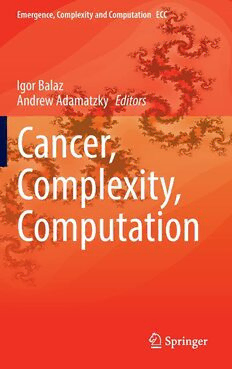Table Of ContentEmergence, Complexity and Computation ECC
Igor Balaz
Andrew Adamatzky Editors
Cancer,
Complexity,
Computation
Emergence, Complexity and Computation
Volume 46
SeriesEditors
IvanZelinka,TechnicalUniversityofOstrava,Ostrava,CzechRepublic
AndrewAdamatzky,UniversityoftheWestofEngland,Bristol,UK
GuanrongChen,CityUniversityofHongKong,HongKong,China
EditorialBoard
AjithAbraham,MirLabs,USA
AnaLucia,UniversidadeFederaldoRioGrandedoSul,PortoAlegre,RioGrande
doSul,Brazil
JuanC.Burguillo,UniversityofVigo,Spain
SergejCˇelikovský,AcademyofSciencesoftheCzechRepublic,CzechRepublic
MohammedChadli,UniversityofJulesVerne,France
EmilioCorchado,UniversityofSalamanca,Spain
DonaldDavendra,TechnicalUniversityofOstrava,CzechRepublic
AndrewIlachinski,CenterforNavalAnalyses,USA
JouniLampinen,UniversityofVaasa,Finland
MartinMiddendorf,UniversityofLeipzig,Germany
EdwardOtt,UniversityofMaryland,USA
LinqiangPan,HuazhongUniversityofScienceandTechnology,Wuhan,China
GheorghePa˘un,RomanianAcademy,Bucharest,Romania
HendrikRichter,HTWKLeipzigUniversityofAppliedSciences,Germany
JuanA.Rodriguez-Aguilar ,IIIA-CSIC,Spain
OttoRössler,InstituteofPhysicalandTheoreticalChemistry,Tübingen,Germany
VaclavSnasel,TechnicalUniversityofOstrava,CzechRepublic
IvoVondrák,TechnicalUniversityofOstrava,CzechRepublic
HectorZenil,KarolinskaInstitute,Sweden
The Emergence, Complexity and Computation (ECC) series publishes new devel-
opments, advancements and selected topics in the fields of complexity, computa-
tionandemergence.Theseriesfocusesonallaspectsofreality-basedcomputation
approachesfromaninterdisciplinarypointofviewespeciallyfromappliedsciences,
biology,physics,orchemistry.Itpresentsnewideasandinterdisciplinaryinsighton
themutualintersectionofsubareasofcomputation,complexityandemergenceand
itsimpactandlimitstoanycomputingbasedonphysicallimits(thermodynamicand
quantum limits, Bremermann’s limit, Seth Lloyd limits…) as well as algorithmic
limits (Gödel’s proof and its impact on calculation, algorithmic complexity, the
Chaitin’sOmeganumberandKolmogorovcomplexity,non-traditionalcalculations
likeTuringmachineprocessanditsconsequences,…)andlimitationsarisinginarti-
ficial intelligence. The topics are (but not limited to) membrane computing, DNA
computing, immune computing, quantum computing, swarm computing, analogic
computing, chaos computing and computing on the edge of chaos, computational
aspectsofdynamicsofcomplexsystems(systemswithself-organization,multiagent
systems,cellularautomata,artificiallife,…),emergenceofcomplexsystemsandits
computationalaspects,andagentbasedcomputation.Themainaimofthisseriesis
to discuss the above mentioned topics from an interdisciplinary point of view and
present new ideas coming from mutual intersection of classical as well as modern
methods of computation. Within the scope of the series are monographs, lecture
notes, selected contributions from specialized conferences and workshops, special
contributionfrominternationalexperts.
IndexedbyzbMATH.
Moreinformationaboutthisseriesathttps://link.springer.com/bookseries/10624
·
Igor Balaz Andrew Adamatzky
Editors
Cancer, Complexity,
Computation
Editors
IgorBalaz AndrewAdamatzky
UniversityofNoviSad UnconventionalComputingLaboratory
NoviSad,Serbia UniversityoftheWestofEngland
Bristol,UK
ISSN 2194-7287 ISSN 2194-7295 (electronic)
Emergence,ComplexityandComputation
ISBN 978-3-031-04378-9 ISBN 978-3-031-04379-6 (eBook)
https://doi.org/10.1007/978-3-031-04379-6
©TheEditor(s)(ifapplicable)andTheAuthor(s),underexclusivelicensetoSpringerNature
SwitzerlandAG2022
Thisworkissubjecttocopyright.AllrightsaresolelyandexclusivelylicensedbythePublisher,whether
thewholeorpartofthematerialisconcerned,specificallytherightsoftranslation,reprinting,reuse
ofillustrations,recitation,broadcasting,reproductiononmicrofilmsorinanyotherphysicalway,and
transmissionorinformationstorageandretrieval,electronicadaptation,computersoftware,orbysimilar
ordissimilarmethodologynowknownorhereafterdeveloped.
Theuseofgeneraldescriptivenames,registerednames,trademarks,servicemarks,etc.inthispublication
doesnotimply,evenintheabsenceofaspecificstatement,thatsuchnamesareexemptfromtherelevant
protectivelawsandregulationsandthereforefreeforgeneraluse.
Thepublisher,theauthors,andtheeditorsaresafetoassumethattheadviceandinformationinthisbook
arebelievedtobetrueandaccurateatthedateofpublication.Neitherthepublishernortheauthorsor
theeditorsgiveawarranty,expressedorimplied,withrespecttothematerialcontainedhereinorforany
errorsoromissionsthatmayhavebeenmade.Thepublisherremainsneutralwithregardtojurisdictional
claimsinpublishedmapsandinstitutionalaffiliations.
ThisSpringerimprintispublishedbytheregisteredcompanySpringerNatureSwitzerlandAG
Theregisteredcompanyaddressis:Gewerbestrasse11,6330Cham,Switzerland
Preface
Cancer is the most enigmatic health disorder humanity ever experienced. The last
decade witnessed rethinking and reunderstanding of cancer. Cancer is not an evil
creature.Itisjustacreaturewhowantstolive,asallotherlivingbeingsdo.Thebook
brings together biomedical scientists, biophysicists, mathematicians and computer
scientists.Theysharetheirunorthodoxviewsonorigins,progressandtreatmentof
cancer.J.JamesFrostopensthebookwithhischapteruncoveringtwokeyproper-
tiesofcancer:symmetry-breakingandcomputationalintelligence.ThenPrzemyslaw
Waliszewskidiscussescancerinthelightofcomplementarity,complexityandfractal
dynamics.AchapterfromThomasE.Yankeelov’slaboratoryanalysisofhowmedical
imaging technologies can be used to obtain patient-specific parameters for mathe-
matical models of cancer is given. The effects of over-feeding in computational
modelsoftumourgrowtharediscussedbyPanPantziarkaandcolleagues.Conway’s
GameofLifecellularautomataaremodifiedwithglobalcouplinginthechapterby
VladimirGarcía-Moralesandcolleaguestomodeltumourgrowth.OscarJ.Suarez
andcolleaguesdiscussthepotentialofcontrollinggeneticregulatorynetworkstotune
cellular response to cancer. Milos Savic and colleagues present implementations
of heterogeneous tumour modelling with PhyssiCell software and the implication
of the heterogeneity in precision medicine. Sensitivity analysis of the cancer stem
cells dynamical simulation is studied by Branislava Lalic and Igor Balaz. Marina
Kovacevic presents her pioneer results on the molecular multiscale simulation of
nanocarriers for cancer treatment. Michail-Antisthenis Tsompanas and colleagues
present a haploid-diploid evolutionary algorithm for the Optimization of nanopar-
ticles for cancer treatment. Perspectives of nanomedicine for cancer treatment are
overviewedbyPetraGenerandcolleagues.AchapterfromtheSabineHauer’sgroup
outlinesthefutureofcancermedicinebasedonswarmsofnanorobots.Thebookends
withachapteronmodellingofangiogenesiswithdifferentialequationsandcellular
automataauthoredbyIoannisKarafyllidisandcolleagues.BenedettaCasadeiwith
co-authorsoverviewstrategiesandmathematicalmodelstostudythecomplexityof
v
vi Preface
drugresistanceincancer.HectorZenilandcolleaguesdiscusshowtousecomputa-
tionalanalysistounravelthecomplexityoftheimmunesystem.Thebookismostly
self-contained and well-illustrated, and chapters are written in a lively style. The
book is accessible to readers from all walks of life and level of education, from
laymenandhighschoolstudentstoexperiencedresearchers.
NoviSad,Serbia IgorBalaz
Bristol,UK AndrewAdamatzky
March2022
Contents
WhatCancerIs ................................................... 1
J.JamesFrost
Complementarity,ComplexityandtheFokker–PlanckEquation;
from the Microscale Quantum Stochastic Events to Fractal
DynamicsofCancer ............................................... 19
PrzemyslawWaliszewski
Quantitative In Vivo Imaging to Enable Tumour Forecasting
andTreatmentOptimization ....................................... 55
GuillermoLorenzo, DavidA.HormuthII, AngelaM.Jarrett,
ErnestoA.B.F.Lima, ShashankSubramanian, GeorgeBiros,
J.TinsleyOden,ThomasJ.R.Hughes,andThomasE.Yankeelov
TheEffectofOver-FeedinginaComputationalModelofTumour
Growth ........................................................... 99
PanPantziarka,LinaGhibelli,andAlbrechtReichle
Modeling Tumour Growth with a Modulated Game of Life
CellularAutomatonUnderGlobalCoupling ......................... 117
VladimirGarcía-Morales,JoséA.Manzanares,andJavierCervera
Pinning Control to Regulate Cellular Response in Cancer
forthep53-Mdm2GeneticRegulatoryNetwork ...................... 133
OscarJ.Suarez,CarlosJ.Vega,EdgarN.Sanchez,GuanrongChen,
AnaE.González-Santiago,OtonielRodríguez-Jorge,AlmaY.Alanis,
andEstebanA.Hernandez-Vargas
Heterogeneous Tumour Modeling Using PhysiCell and Its
ImplicationsinPrecisionMedicine .................................. 157
MilošSavic´,VladimirKurbalija,IgorBalaz,andMirjanaIvanovic´
vii
viii Contents
LocalQuantitativeandQualitativeSensitivityAnalysisofCSC
DynamicalSimulation ............................................. 191
BranislavaLalicandIgorBalaz
The Role of Molecular Dynamics Simulations in Multiscale
ModelingofNanocarriersforCancerTreatment ..................... 209
MarinaKovacevicandIgorBalaz
A Haploid-Diploid Evolutionary Algorithm Optimizing
NanoparticleBasedCancerTreatments .............................. 237
Michail-AntisthenisTsompanas,LarryBull,AndrewAdamatzky,
andIgorBalaz
Drawbacks of Bench to Bed Translation of Nanomedicines
forCancerTreatment .............................................. 253
PetraGener,AnnaUlldemolins,andSimoSchwartzJr.
Swarms:TheNextFrontierforCancerNanomedicine ................ 269
MatimbaSwana, JohannaBlee, NamidStillman, JonathanIves,
andSabineHauert
StudyofTumourInducedVesselDisplacementintheTumour
ProgressionRatewithAdvancedBioinspiredComputationalTools ..... 289
IoannisKarafyllidis, GeorgiosCh.Sirakoulis,
andRaphaelSandaltzopoulos
Complexities of Drug Resistance in Cancer: An Overview
ofStrategiesandMathematicalModels .............................. 309
BenedettaCasadei, MartaGiacosa, AlessandroMaula, SaraPlos,
LetiziaZappulla,CamillaViotto,MarcoA.Deriu,andJackA.Tuszynski
The Immune System in Health and Disease: The Need
forPersonalisedLongitudinalMonitoring ........................... 333
HectorZenil,AbicumaranUthamacumaran,andKouroshSaeb-Parsy
What Cancer Is
J.JamesFrost
…itseemstomethatImustconsiderascontainedinthe
individualconceptofmyselfonlythatwhichissuchthatIshould
notlongerbemeifitwerenotinme:andthatallthatistothe
contrarysuchthatitcouldbeornotbeinmewithoutmyceasing
tobeme,cannotbeconsideredinmyindividualconcept.
LetterfromAntoineArnauldtoGottfriedLeibniz[1].
Abstract The problem of cancer is examined from the metaphysical standpoint
of essence and ground. An essentialist definition of cancer is assumed that would
be valid in all possible worlds in which cancer could logically exist. The grounds
of cancer are then examined and elucidated. Two grounding cancer properties are
identifiedanddiscussed:symmetry-breakingandcomputationalintelligence.Each
examination leads to concrete conclusions for novel therapeutic approaches and a
morefundamentalunderstandingofwhatcancerisatbottom.Otherpossiblecancer
grounding properties related to evolution, adaptability and stochastic features are
identified for future work. This approach is novel and offers new solutions to the
problemofcancer.
· · · ·
Keywords Cancer Intelligence Symmetry-breaking Computation Ground
1 Introduction
Identifying a solution to the unsolved problem of cancer is currently based on a
program of scientific reductionism, in which each new solution attempt provides
temporarypatientbenefituntiltheoncologistandthefieldofoncologyitselfreaches
the end of yet another box canyon.1 In 1990 5.7 million people died from cancer
worldwide; in 2017 the number of deaths increased to 9.6 million. Each new
1Acanyonwithverticalwallsandclosedupstreamwithasimilarverticalwall,thatis,adeadend.
B
J.J.Frost( )
Professoremeritus,BioMolecularImaging,Baltimore,MD21218,USA
e-mail:jfrost@jhmi.edu;jjamesfrost@comcast.net
©TheAuthor(s),underexclusivelicensetoSpringerNatureSwitzerlandAG2022 1
I.BalazandA.Adamatzky(eds.),Cancer,Complexity,Computation,
Emergence,ComplexityandComputation46,
https://doi.org/10.1007/978-3-031-04379-6_1

